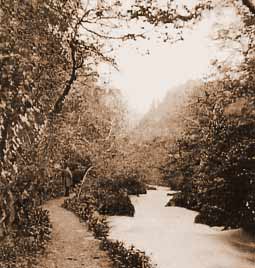Historical Walking Tour of Lower Doon
Doon is a suburb and former village in what is now Kitchener, Ontario. The earliest documented evidence of human settlement in the area goes back to 1500s when at least 2 indigenous groups existed in the Kitchener area, although it is believed that the area was used much earlier. These groups are believed to be the ancestors of the Neutral Nation. One of these villages was located in what is now Huron Natural area, 6km away from Homer Watson House & Gallery. The archaeological remains of 10 longhouses, pottery, bone and stone tools have been found at the site. The residents would have used the Grand River as an important source of transportation, fishing and foraging. It is likely that the trail along the river in Homer Watson Park was frequented by this group and others.
In 1784, an area 6 miles deep on either side of the Grand River was promised to the Six Nations by the British government to provide a new territory for the indigenous peoples who supported them during the American revolution. This was known as the Haldimand Treaty. The Neutral Nations who previously inhabited the area had been largely decimated by illnesses brought over by European settlers. The land was put in the guardianship of “Indian agents” and was leased, sold and reduced over a period of several years. The land was subsequently settled by early Mennonite pioneers.

Doon owes its name to Adam Ferrie Jr., who came in 1834 to this section of the Grand River in search of a location to construct a mill. He found it at the confluence of Schneider’s Creek and the Grand River. The area reminded Ferrie of the River Doon, near Ayrshire, Scotland.
The Loch Doon area was memorialized in celebrated Scottish poet, Robert Burns piece “Ye banks and braes O’ bonnie Doon”
Ferrie came from a very industrious and wealthy family. He bought 300 acres of land and cleared 100 to construct what must have seemed like an empire to the earlier settlers: a stone mill for flour, barley and oatmeal, a distillery, a store, a cooperage (a factory producing casks and barrels) and several homes. The Ferrie companies became a major source of employment and prosperity for the growing community of Doon.
By 1852 the Ferrie enterprises included the grist mill (for grinding grain into flour), a saw mill, tailor shop, blacksmith, shoemaker, wagonmaker, cooperage, tavern, farm, distillery, the Doon Inn, two stores, eleven houses for its workers and twenty lots that were sold to residents. The population of the entire community according to the 1851 census was 452. Robert Ferrie also established a Post office and served as the Postmaster. By 1855, when Watson was born, Lower Doon was still essentially a “company town”.
Doon owes its creation to these earlier settlers, but it is Homer Watson’s paintings that give us our best glimpse of pioneer life in Doon. His works reflect the life and circumstances of our earliest pioneers, the beauty of nature and man’s imprint on it. He painted the trees and fields of Doon in all weathers and seasons. Homer Watson has been described as “the man who first saw Canada as Canada”. Watson felt the artist had to understand the pioneer stage of a country and its development. Not only to understand but to love and respect “the manner in which we bind inanimate nature into serving our will”.
Follow this walking tour of Doon to learn more about the history and beauty of Homer Watson’s Canada.
*Some of the historic places on this tour are now private houses, please be respectful of the owners and their properties.
** Click on the images to enlarge them
This tour has been created in collaboration with Kitchener Public Library and the Waterloo Historical Society.
Cordwainer’s Cottage
1755 Old Mill Road
This Georgian brick-over-wood frame house was built in 1873 and is typical of a worker’s cottage for the period. Its first owner was John L. Beyer, a cordwainer (a shoemaker who makes new shoes from new leather, unlike a cobbler who traditionally only repairs shoes). In 1876, it was sold to Joseph Firestine, a shoemaker from Galt.
Doon Mills
next to 1782 Old Mill Road
The Doon Mills were completed in 1839. Today, a corner of a stone wall, a date marker and the race (a channel used to direct a strong current of water to the mill’s wheel) are all that remain. A dam was built in front of the mill to fill the race, creating a small lake that took seventy hours to fill. The site of the lake is now a playground, which can be seen across the bridge.
The mill was constructed out of hewn rubble at great cost and labour only to be washed away in 1840 when the dam developed a quicksand bed and burst its wall. The mill pond emptied in ten minutes carrying away portions of the stone mill, distillery, trees, tenant houses and breaking up an ice flow 20 inches thick. Everything was deposited about a mile down river.
Adam Ferrie rebuilt the dam, but the site was later taken over by his brother Robert at the request of his father. Adam was certain Robert could not administer the affairs of the company: “My brother will not be able to manage the business, it will go to ruin. My father has greatly wronged me, but I have obeyed him to the last”. The property was transferred to Robert in 1847 for 400 pounds. Robert wrote to his brother in 1849, telling him not to bother giving him advice, as Adam was prone to do, as he was quite capable of running his own affairs. Adam Jr. died in 1848 at the age of 36. Robert was elected to Parliament in 1854, but his health was failing. He was a leading member of the community, but was scandalized by an employee who falsified the mill accounts. By 1857, Ferrie & Co. was operating under financial constraints and after Robert’s death in 1860, at the age of 38, the estate lost the mill to the Gore Bank, which held a $25,000 mortgage.
The mill exchanged hands several times after this. By 1893, it was sold to Jacob Cluthe, who updated the dam. Fire destroyed much of the mill in 1898. It was roofed over and used as a shoddy mill with a cider and glue factory in the basement (quite a combination!). He also manufactured scissors for several years. Fire again broke out in 1921 or 1922 and destroyed the structure beyond repair. The smokestack and granary at the front rotted away and the walls crumbled. Pressure from flooding of the creek knocked over the west wall of the mill in 1965. Behind the mill, 150 feet along the trail and to the left, is what remains of a storehouse. Some plaster on the rubble work can still be seen.
Willow Lake (Now Willowlake Park)
Next to 661 Mill Park Drive and opposite the Mill Ruins
The millpond across from Ferrie’s mill was known as Willow Lake and became a favoured resort and weekend retreat operated by the Cluthe family in the 1930s.
Homer Watson refers to the millpond in his essay, “A Landscape Painter’s Day” (1890):
“I had long nourished an intention of going to a pond that nestled among willow in the neighbourhood. The dell lingered in my thought as the most charming place in the vicinity. It combined pastoral peace and wildness, and an aroma of friendliness seemed to exhale from its luxuriant canopies.”
During the Great Depression, the Cluthe family opened the millpond, “Willow Lake” to visitors adding a sand beach, a high-dive platform, concession stands and cabins. The lake was used by locals for swimming in the summer and skating throughout the winter. A 1968 storm badly damaged a gate on the dam and the waters of Willow Lake drained into the Grand River. Today the lake site is a City of Kitchener property, called Willowlake Park. The site will be the home of a new pumping station.
Regency Cottage
20 Pinnacle Drive
The Ferrie Company sold plots of land to local residents in an effort to establish a community. Robert Ferrie complained in letters to his father that “Doon had no society…I could live as a hermit here…the sooner the lots are sold, the more the likelihood of a village starting up”.
This regency style cottage was built by Xavier Pfieffer in 1858. He was a local carpenter who installed the floor and pews of the Doon Presbyterian Church. The style was popular in the early part of the 19th century. Pfieffer appears to have built the cottage as an investment, as he mortgaged the site three times in 1858 for a total of $800 and sold the property in 1859 to a John Fink. The veranda has been rebuilt, but the structure remains true to its functionality and charm.
The Red Lion Inn
37 Pinnacle Drive
Boasting, “stable for 6 horses, 7 beds, cellar full, house well kept”, the Red Lion Inn served the community of Doon from as early as 1858 under two roofs. A frame building across the street was the original Inn. It was replaced by the present building in 1892 and Nancy Jamieson was the proprietor. James Green bought the building in 1921 and converted it to a private home. In the 1940s, Room and board were still available to students of the Doon School of Fine Arts at a rate of $32.50 per week.
The Inn served the crew and passengers of the Grand Trunk Railway, which ran from Preston to Berlin (Kitchener) and provided freight and passenger service to Doon. In 1857, a flood washed out the rail bridge over the Grand River. A new line on the west bank was built to avoid the river in 1872. The Dutch Mail Run as it was known, stopped in Doon four times daily. The station was directly across the street from this building.
Railway Station
A railway station opened around 1867 as part of the Grand Trunk line from Galt to Elmira. A daily service called the Dutch Mail carried passengers and mail between Doon and Kitchener (then Berlin). The Doon station and line no longer exist, but parts of the Grand Trunk Railway are still used by Canadian National (CN).
39 Doon Valley Drive
This interesting stone building utilizes two construction materials, fieldstone and cutstone. Originally owned by Adam Ferrie Jr., the house changed hands five times before the turn of the century. The house was built around 1840 and sold to Samuel Schneider in 1869 by the Gore Bank along with 191 acres of land. The front porch and an addition to the back of the dwelling were added after 1980. Across the street stood the Ferrie cooperage.
Allen (Kinzie) House
26 Durham Street
This house was the home of William Allen (1803-1879). Allen was a merchant dealing in dry goods, meats and produce. He purchased four lots from the Ferries in 1858 for $72 and had this Gothic stone house built in 1860. It appears to be two stories but is actually a storey-and-a-half. This was a clever way to save on taxes as assessments were made according to the number of storeys, meaning that Allen only had to pay taxes on a one storey house, but essentially had the benefit of two storeys. A spring house in the backyard pumped water from the river, assuring a good supply and easing Allen’s labour. His granddaughters, Henrietta and Catherine Bowman (Bauman) took possession of the house in 1928 and Earl Henry Kinzie bought the property in 1958.
The empty lot adjacent to the house was the site of the Wesleyan Methodist Church. The land was donated by William Allen. The church’s exterior light, which could be seen from across the river, summoned parishioners to evening services. In 2019, after years of neglect and without a permit, the property owner demolished the church.
Christadelphian Meeting House
Old Mill Road before Pinnacle Drive, building no longer present
The religious flavour of Doon was abundant – Presbyterian, Methodist, Lutheran, Mennonite, as well as an old sect called Christaldelphian, taken from the Greek “Christou Adelphoi”, meaning Brethren of Christ. The Christadelphians did not have churches or preachers but rather held meetings to discuss the scriptures. In 1889, they erected a Meeting House overlooking the river on Old Mill Road. They leased land and property for 99 years at $1 per year. Unfortunately, the building no longer exists.
Homer Watson’s mother, Susannah, was a devout Christadelphian and held meetings at her home and attended meetings at this meeting house. When Homer was born, he was baptized as Christadelphian, but as an adult, Homer’s religious views were more fluid. He was interested in both Christian scriptures and Spiritualism. He was a preacher in his own way, but nature was his church, and the easel his pulpit. Homer wrote, “It is the spirit that paints, if only I knew enough to let it take control. That’s when I make my best pictures, but the trouble is my carnal mind comes in and meddles too much. Then I make a mess of it, and that is what happens most of the time, I think”.
Pioneer Memorial Tower
300 Lookout Ln, best viewed from the bridge at Pinnacle Drive and Old Mill Road
Crossing the bridge over Schneider’s Creek, the Pioneer Memorial tower can be seen on the other side of the Grand River. The tower was built in 1925, and on August 26, 1926 it was dedicated to honour the first Mennonite settlers. Joseph Schoerg and Samuel Betzner moved from Franklin County, Pennsylvania and settled on the east bank of the Grand in 1800.
According to land records, John Biehn and George Bechtel have the honour of being the first settlers in the county. Their purchase was registered on July 18, 1800. It was not until August 13, that Samuel Betzner and his son registered their land and Joseph Schoerg waited until September 5, 1800. The tower is built on Betzner’s homestead and there is also a cemetery with family graves on the site.
Homer Watson Park
Watson was increasingly distressed by the demolition of the majestic virgin forest of Ontario and developed a scheme to preserve at least a small portion of it. In 1913, a tract of land known as “Cressman Bush” was to be auctioned and Watson feared it would go to a portable sawmill owner. A group of concerned parties formed the Waterloo County Grand River Park Limited and named Watson the president. They purchased the land with the intention of preserving it as a park forest.
In 1976, the City of Kitchener designated this land as an ecologically significant open space and further ensured its preservation. The park comprises 250 acres, supporting a wide variety of plants and wildlife. Pine, spruce, cedar thickets, hemlock and mixed swamp forest can be found in abundance. Dwarf Ginseng, fiddleheads and cancer root all attest to this diversity. Five species of butterfly make their home in the park as well as the rare Red-shouldered Hawk and Black-backed, three-toed Woodpecker. High steep wooded bluffs along the Grand River provide vantage points for impressive views of the river valley, including Bechtel’s Ford. Walking trails and picnic areas are situated in the park.
Doon Presbyterian Church
35 Roos Street
By 1853 the Presbyterian movement in Doon was large enough to warrant a church. Land was donated by Robert Ferrie and a committee formed to collect funds for its construction. Built in the traditional Gothic style, at a cost of approximately $4912.00. 98,124 bricks were used in its construction. It’s first service took place on December 31, 1854. Homer Watson’s sister Phoebe was heavily involved with the church and was one of 11 women who founded Ladies Aid to financially support the church and its needs. The Church remained virtually unchanged until 1992, when a new addition was added.
Homer Watson House & Gallery
1754 Old Mill Road
The house at 1754 Old Mill Road was built by the Ferries, an affluent industrialist family from Scotland. This substantial house, in the vernacular Scottish gothic style is very different from the Georgian style favoured by Mennonite settlers of the early 1800s. The house was built c.1850 on land purchased from John Biehn Jr. by Adam Ferrie to build his mill complex. In 1847, Ferrie’s brother Robert took over the mill and Adam Ferrie passed away the following year at the age of 36.
Homer Watson admired the Ferrie house for its architecture and light since childhood. In the autumn of 1881, he moved into the house with his wife Roxanna, renting the upper floor. The previous year Watson had achieved artistic success when the Marquis of Lorne purchased his painting “The Pioneer Mill” as a gift for Queen Victoria, for the sum of $300. In 1882, the Queen requested another of Watson’s works, “The Last Day of the Drought” and the Marquis also arranged to buy “The Torrent”. Watson now had confidence in his artistic career and the financial means necessary to purchase his dream home.
In 1883, Watson secured the Ferrie house and the two and three quarters acres upon which it was situated. The house would remain Watson’s home for the remainder of his life. By 1893, the painter had added a studio, in which, he later painted a frieze displaying the names of the artists he most admired and landscapes inspired by their works. The year 1906 saw more changes to the house, when a gallery, designed with classical “harmonic proportions”, was added to display Watson’s art. The gallery was intended to show Watson’s works to the many patrons who visited his studio. Clerestory windows allowed natural light to enter the gallery while providing as much wall space as possible to hang his paintings.
Watson continued to work in the house until his death on May 30, 1936. His sister, Phoebe, remained in the house until her death in 1947. The following year the estate was sold to Ross and Bess Hamilton. In 1948 the Hamiltons established the Doon School of Fine Arts. Instructors at the School included notables artists such as Fred Varley of the Group of Seven. The Doon School operated until 1966. Later owners, Earl Putnam and Tom and Ruthe Cayley continued to operate the property as a place of learning offering classes in visual arts and displaying the works of Homer Watson to the public. In 1981 the City of Kitchener purchased the historic house from Ruthe Cayley to ensure its survival for future generations. The Homer Watson house continues to this day to be a community hub for the celebration and practice of the arts.
This completes the tour we hope you enjoyed it! If you would like to complete the Extended tour continue to the following stops:
Doon Presbyterian Cemetery
345 Mill Park Drive
A short walk from Homer Watson House, along Mill Park Drive, The Doon Presbyterian Cemetery and the Kinzie-Biehn Cemetery occupy the corner of Christian Schneider’s 19th Century farm. The cemetery serves at the final resting place for some of the earliest settlers and many prominent residents of Doon.
The Doon Presbyterian Cemetery was donated by Robert Ferrie after he acquired Christian’s land.
Homer Watson is buried here as is his wife, sister and other family members, Ross Hamilton, the Tilt family, William Allen, the Perines and so many significant residents of the area.
Huron Road Crossroads
The corner of Mill Park Drive and Huron Road was once a busy crossroads. Mill Park Drive (formerly known as Cressman’s Road, Bush Road and Wilson Avenue) was part of an early road that linked Berlin (Kitchener) to Preston, Galt and Paris. In 1835, a triweekly stagecoach and mail service used this road on its way from Waterloo though Berlin to Preston. In 1831, mail was carried from Guelph to Goderich every two weeks and many stagecoaches travelled this road stopping at the numerous taverns and inns.
The Bush Inn
At the corner of Mill Park Drive and Huron Road there is a small parking lot for access to Homer Watson Park. This lot marks the original location of the Bush Inn. The Inn was built in the winter of 1853-1854 by Henry Hilborn. The inn would have been frequented by stagecoach patrons. Unfortunately, the inn burned down in 1867 and was not rebuilt. The introduction of the railway in 1857 likely contributed to the demise of this inn and many other stagecoach inns like it.
Homer Watson Memorialized the Bush Inn in his painting On the Old Stage Road, November Night 1881. Although the Inn had already burned down, Watson had fond memories of it, “The old inn had a charm for me. Its long sloping roof, built to carry off the rain and three dormer windows broke the skyline…”
14 Mill Park Drive
For nearly 150 years (1856-2005) a small stone house stood on this site. In 1856, John Wolff, a labourer living at the Bush Inn bought the 1 acre site from Abraham Cressman and built a one and a half storey, four room structure. The walls were 38cm (15”) thick and made of rounded stones from the river. The exterior stones were covered with stucco and then scored to look like ashlar stone blocks. In 1860, Wolff ran a tailor’s shop out of the house. The outline of the house is seen by the layout of large stones you see in front of you.
Bechtel’s Ford (Not visible from the path)
10 Huron Rd
Soon after 1800 a ford was established across the Grand River to open Old Huron Road to the town of Preston. This site, connecting the Biehn and Bechtel tracts, was chosen for its gravel deposits, shallow depth and because an island broke the river into two channels. A bridge was built in 1836 as traffic increased but this was washed out in 1857 in an early spring flood and was never replaced. Ben Uttley, a local resident and teacher, laid a cable over the river, attached a basket and pulled himself across each day as a shortcut to school! There were many such fords along the Grand and Homer Watson’s painting “Pioneers Crossing the River” was no doubt inspired by just such a ford.
Ken Seiling Waterloo Region Museum & Doon Heritage Village
10 Huron Rd
The 20th century begins in Waterloo County at the Ken Seiling Waterloo Region Museum. Set against a beautiful, environmentally sensitive forest, Doon Heritage Village is a re-creation of a rural village and two farms, where costumed interpreters welcome you to the year 1914. Over twenty historic buildings, period furnishings, farm animals, heritage gardens, and demonstrations of daily chores help visitors discover an exciting era of change in Canadian history. Visit waterlooregionmuseum.ca to learn more.












